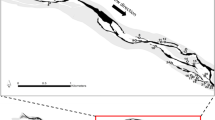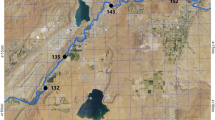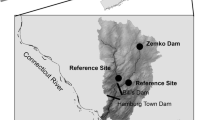Abstract
Models of community regulation commonly incorporate gradients of disturbance inversely related to the role of biotic interactions in regulating intermediate trophic levels. Higher trophic-level organisms are predicted to be more strongly limited by intermediate levels of disturbance than are the organisms they consume. We used a manipulation of the frequency of hydrological disturbance in an intervention analysis to examine its effects on small-fish communities in the Everglades, USA. From 1978 to 2002, we monitored fishes at one long-hydroperiod (average 350 days) and at one short-hydroperiod (average 259 days; monitoring started here in 1985) site. At a third site, managers intervened in 1985 to diminish the frequency and duration of marsh drying. By the late 1990s, the successional dynamics of density and relative abundance at the intervention site converged on those of the long-hydroperiod site. Community change was manifested over 3 to 5 years following a dry-down if a site remained inundated; the number of days since the most recent drying event and length of the preceding dry period were useful for predicting population dynamics. Community dissimilarity was positively correlated with the time since last dry. Community dynamics resulted from change in the relative abundance of three groups of species linked by life-history responses to drought. Drought frequency and intensity covaried in response to hydrological manipulation at the landscape scale; community-level successional dynamics converged on a relatively small range of species compositions when drought return-time extended beyond 4 years. The density of small fishes increased with diminution of drought frequency, consistent with disturbance-limited community structure; less-frequent drying than experienced in this study (i.e., longer return times) yields predator-dominated regulation of small-fish communities in some parts of the Everglades.






Similar content being viewed by others
References
Anonymous (1988) Guidelines for use of fishes in field research. Fisheries 13:16–23
Baber MJ, Childers DL, Babbitt KJ, Anderson DH (2002) Controls on fish distribution and abundance in temporary wetlands. Can J Fish Aquat Sci 59:1441–1450
Bell T, Neill WE, Schluter D (2003) The effect of temporal scale on the outcome of trophic cascade experiments. Oecologia 134:578–586
Benda L, Poff NL, Miller D, Dunne T, Reeves G, Pess G, Pollock M (2004) The network dynamics hypothesis: how channel networks structure riverine habitats. Bioscience 54:413–427
Benedetti-Cecchi L (2003) The importance of the variance around the mean effect size of ecological processes. Ecology 84:2335–2346
Boulton AJ (2003) Parallels and contrasts in the effects of drought on stream macroinvertebrate assemblages. Freshwater Biol 48:1173–1185
Burnham KP, Anderson DR (2002) Model selection and multimodel inference. A practical information-theoretic approach, 2nd edn. Springer, Berlin Heidelberg New York
Busch DE, Loftus WF, Bass OL (1998) Long-term effects on marsh plant community structure in the southern Everglades. Wetlands 18:230–241
Chase JM (2003) Community assembly: when should history matter? Oecologia 136:489–498
Chase JM, Leibold MA (2003) Ecological niches: linking classical and contemporary approaches. University of Chicago Press, Chicago
Chick JH, Coyne S, Trexler JC (1999) Effectiveness of airboat electrofishing for sampling fishes in shallow vegetated habitats. N Am J Fish Manage 19:957–967
Chick JH, Ruetz CR III, Trexler JC (2004) Spatial scale and abundance patterns of large fish communities in freshwater marshes of the Florida Everglades. Wetlands 24:652–664
Clarke KR (1993) Non-parametric multivariate analyses of change in community structure. Aust J Ecol 18:117–143
Clarke KR, Warwick RM (1994) Change in marine communities: an approach to statistical analysis and interpretation. Natural Environmental Research Council Plymouth Marine Laboratory, UK
Douglas ME, Endler JA (1982) Quantitative matrix comparisons in ecological and evolutionary investigations. J Theoret Biol 99:777–795
Downes BJ, Barmuta LA, Fairweather PG, Faith DP, Keough MJ, Lake PS, Mapstone BD, Quinn GP (2002) Monitoring ecological impacts: concepts and practice in flowing waters. Cambridge University Press, Cambridge, UK
Fukami T (2001) Sequence effects of disturbance on community structure. Oikos 92:215–224
Gleason PJ, Cohen AD, Stone P, Smith WG, Brooks HK, Goodrick R, Spackman W Jr (1984) The environmental significance of holocene sediments from the Everglades and saline tidal plain. In: Gleason PJ (ed) Environments of South Florida, present and past II, 2nd edn. Miami Geological Society, Coral Gables, pp 297–351
Grime JP (1977) Evidence for the existence of three primary strategies in plants and its relevance to ecological and evolutionary theory. Am Nat 111:1169–1194
Hairston Sr NG (1989) Ecological experiments. Purpose, design, and execution. Cambridge University Press, Cambridge
Harrington Jr RW (1959) Delayed hatching in stranded eggs of marsh killifish, Fundulus confluentius. Ecology 40:430–437
Holling CS (1986) The resilience of terrestrial ecosystems: local surprise and global change. In: Clark WC, Munn RE (eds) Sustainable development of the biosphere. Cambridge University Press, Cambridge, pp 292–317
Huston MA (1994) Biological diversity. Cambridge University Press, Cambridge
Inouye RS, Tilman D (1995) Convergence and divergence of old-field vegetation after 11 yr of nitrogen addition. Ecology 76:1872–1887
Jordan F, Coyne S, Trexler JC (1997) Sampling fishes in vegetated habitats: effects of habitat structure on sampling characteristics of the 1-m2 throw trap. Trans Am Fisheries Soc 126:1012–1020
Jordan F, Babbitt KJ, McIvor CC (1998) Seasonal variation in habitat use by marsh fishes. Ecol Freshwater Fish 7:159–166
Kruskal JB, Wish M (1978) Multidimensional scaling. Sage university paper series on quantitative applications in the social sciences, 07–0111. Sage Publications, Beverly Hills
Kushlan JA (1974) Quantitative sampling of fish populations in shallow, freshwater environments. Trans Am Fisheries Soc 103:348–352
Kushlan JA (1976) Environmental stability and fish community diversity. Ecology 57:821–825
Kushlan JA (1980) Population fluctuations of Everglades fishes. Copeia 1980:870–874
Legendre P, Legendre L (1998) Numerical ecology, 2nd edn. Elsevier, Amersterdam
Littell RC, Milliken GA, Stroup WW, Wolfinger RD (1996) SAS System for mixed models. SAS Institute Inc, Cary
Loftus WF, Eklund A-M (1994) Long-term dynamics of an Everglades small-fish assemblage. In: Davis S, Ogden JC (eds) Everglades: the system and its restoration. St Lucie Press, Delray Beach, pp 461–483
Magoulick DD, Kobza RM (2003) The role of refugia for fishes during drought: a review and synthesis. Freshwater Biol 48:1186–1198
Mantel N (1967) The detection of disease clustering and generalized regression approach. Cancer Res 27:209–220
McCabe DJ, Gotelli NJ (2000) Effects of disturbance frequency, intensity, and area on assemblages of stream macroinvertebrates. Oecologia 124:270–279
McCullagh P, JA Nelder (1989) Generalized linear models, 2nd edn. Chapman & Hall/CRC, Boca Raton
Menge BA, Sutherland JP (1987) Species diversity gradients: a synthesis of the roles of predation, competition and temporal heterogeneity. Am Nat 110:351–369
Murtaugh PA (2000) Paired intervention analysis in ecology. J Agri Biol Environ Statist 5:280–292
Murtaugh PA (2002) On rejection rates of paired intervention analysis. Ecology 83:1752–1761
Philippi TE, Dixon PM, Taylor BE (1998) Detecting trends in species composition. Ecol Appl 8:300–308
Ranta E, Kaitala V, Lindström J (1999) Spatially autocorrelated disturbances and patterns in population synchrony. Proc Roy Soc London B 266:1851–1856
Rasmussen PW, Heisey DM, Nordheim EV, Frost TM (1993) Time-series intervention analysis: unreplicated large-scale experiments. In: Scheiner SM, Gurevitch J (eds) Design and analysis of ecological experiments. Chapman & Hall, New York, pp 138–158
Ruetz CR III, Trexler JC, Jordan F, Loftus WF, Perry SA (2005) Population dynamics of wetland fishes: spatiotemporal patterns shaped by hydrological disturbance? J Anim Ecol 74:322–332
Samuels CL, Drake JA (1997) Divergent perspectives on community convergence. Trends Ecol Evol 12:427–432
Snodgrass JW, Bryan AL, Lide RF, Smith GM (1996) Factors affecting the occurrence and structure of fish assemblages in isolated wetlands of the upper coastal plain, USA. Can J Fish Aquat Sci 53:443–454
Stewart-Oaten A (2003) On rejection rates of paired intervention analysis: comment. Ecology 84:2795–2799
Tilman D (1988) Plant strategies and the dynamics and structure of plant communities. Princeton University Press, Princeton
Trexler JC, Loftus WF, Jordan CF, Chick J, Kandl KL, McElroy TC, Bass OL (2001) Ecological scale and its implications for freshwater fishes in the Florida Everglades. In: Porter JW, Porter KG (eds) The Everglades, Florida Bay, and coral reefs of the Florida Keys: an ecosystem sourcebook. CRC Press, Boca Raton, pp 153–181
Trexler JC, Loftus WF, Chick J (2003) Setting and monitoring restoration goals in the absence of historical data: the case of fishes in the Florida Everglades. In: Busch D, Trexler JC (eds) Monitoring Ecosystems: interdisciplinary approaches for determining status and trends of ecosystems. Island Press, New York, pp 351–376
Wellborn GA, Skelly DK, Werner EE (1996) Mechanisms creating community structure across a freshwater habitat gradient. Annu Rev Ecol Syst 27:337–363
Wolski LF, Trexler JC, Nelson EB, Philippi T, Perry SA (2004) Assessing visitor impacts from long-term sampling of wetland communities in the Everglades. Freshwater Biol 49:1381–1390
Young TP, Chase JM, Huddleston RT (2001) Community succession and assembly comparing, contrasting and combining paradigms in the context of ecological restoration. Ecol Res 19:5–18
Acknowledgments
The data reported here were collected over many years by a large number of people. We especially acknowledge (in the order of their service) Scott Voorhees, David Tomey, Jane Schmidt, Todd Steiner, Jim Chapman, Anne-Marie Eklund, Sonny Bass, Lori Oberhofer, Jason Osborne, Eric Nelson, and Jeff Kline. Eric Nelson, Victoria Foster, and Carl Ruetz were especially helpful in data management and manipulation. Special thanks go to Tom Philippi, who provided critical assistance on the analyses of these data, and the Trexler lab (especially Nathan Dorn, Jennifer Rehage, and Charles Goss) for comments on the manuscript. While working on this project, Trexler was funded by cooperative Agreement CA5280–8-9003 between Everglades National Park and Florida International University and National Science Foundation grant number 99–10514 for Florida Coastal Everglades Long-Term Ecological Research (FCE-LTER). Loftus and Perry were supported by base funds from the Everglades National Park and USGS. This is publication no. 253 of the Southeast Environmental Research Center at FIU and 93 of the tropical biology program at FIU.
Author information
Authors and Affiliations
Corresponding author
Additional information
Communicated by Libby Marschall
Electronic supplementary material
Rights and permissions
About this article
Cite this article
Trexler, J.C., Loftus, W.F. & Perry, S. Disturbance frequency and community structure in a twenty-five year intervention study. Oecologia 145, 140–152 (2005). https://doi.org/10.1007/s00442-005-0094-4
Received:
Accepted:
Published:
Issue Date:
DOI: https://doi.org/10.1007/s00442-005-0094-4




